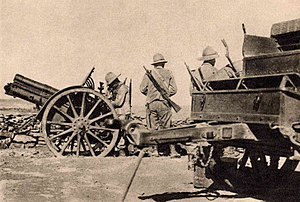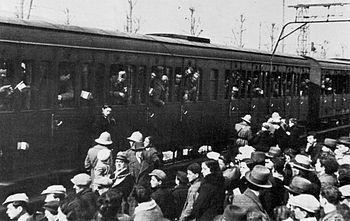The Ethiopia Campaign
On October 3, 1935, “Italy attacked Ethiopia without a declaration of war” in a battle known as the De Bono Offensive (Source). This was led by Italian General Emilio De Bono. Similarly, Italians along with their Somali counterparts pushed into Italy from the south.
Background:
Italy was declared the aggressor, but much like with Russia and Germany, no one bothered to do much of anything about it. Italy declared it’s actions necessary because “the Ethiopian government treated it’s citizens badly and deserved to be attacked” (Source).
Meanwhile, American journalists, bored with the one-sidedness of the war, decided to paint the Ethiopians with a fighting chance, claiming they were giving Italy a fair fight. However untrue this may have been. It did manage to build up sympathy, though.
Truthfully, Ethiopia was no match for Italy, giving them very little fight. In fact, Italy barely lost 1% of the army Mussolini had sent over.
[Below: Italian artillery in Ethiopia]

That is, until the Christmas Offensive. Here, the Ethiopians bushed back the Italian armies, hoping to split the Italian armies “in the north with the Ethiopian center, crushing the Italian left with the Ethiopian right, and invading Eritrea with the Ethiopian left” (Source). With their force 200,000 strong, the Ethiopians proved that maybe the Americans had been right all along – and the Italians wrong in their assumption that the Ethiopians wouldn’t give them much of a fight. Using old school tactics, they defeated the Italians at “Dembeguina Pass in the northwest of the country” (Source).
“The Italian commander, Major Criniti, commanded a force of 1,000 Eritrean Infantry supported by L3 tanks. When the Ethiopians attacked, Criniti’s force fell back to the pass, only to discover that 2,000 Ethiopian soldiers had occupied it. Criniti’s force was encircled and taking fire from all directions. In the first Ethiopian attack, two of Major Criniti’s officers were killed, and Criniti himself was wounded. Criniti’s force attempted to use their L3 tanks to break out, but the rough terrain immobilized the vehicles” (Source).
In short, the Italian infantry was slaughtered. In response, the Italians sent for a relief column, led by Major Criniti. But they, too, were ambushed by the Ethiopians, who swarmed the Italian tanks, blocking their path with large boulders. Two more Italian tanks were immobilized by the terrain and, unable to move any further, found their tanks set on fire by the Ethiopians.
“Meanwhile, Major Critini achieved a breakout, having ordered his men to fix bayonets and charge” (Source). They were eventually able to escape their Ethiopian encirclement, but not without some 3,000 deaths.
Frustrated that their invasion wasn’t as easy as they’d planned, the Italians “decided to use mustard gas, bombers, and long-range artillery to force the Emperor Haile Selassie I to capitulate” (Source). The Ethiopians, with their spears and swords, couldn’t hope to meet this kind of invasion.
As a result, their emperor fled, and the capital, Addis Ababa, slipped into chaos, “slipped into anarchy when an angry mob destroyed all shops owned by Europeans” (Source). By June 1, they had been annexed by Italy.
[Below: Italian soldiers and immigrants leaving for Ethiopia in 1935]

Up Next:
The Enemy Within: Stalin’s Purge of the Red Army

